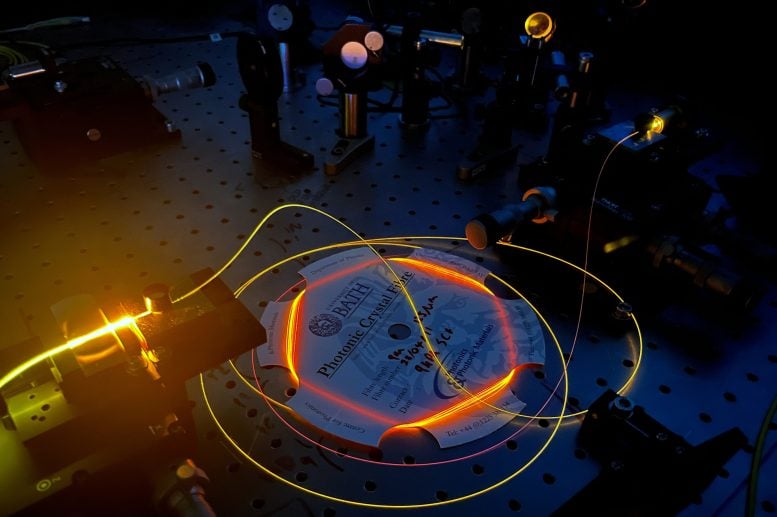
Bright light guided through an optical fiber manufactured at the University of Bath. Credit: Cameron McGarry, University of Bath
Physicists at the University of Bath in the UK have developed a new generation of specialty optical fibers designed to address future data transfer challenges anticipated with the rise of quantum computing.
Physicists at the University of Bath in the UK have developed a new generation of specialty optical fibers designed to meet the anticipated data transfer challenges of the upcoming quantum computing era.
Quantum technologies promise to provide unparalleled computational power, allowing us to solve complex logical problems, develop new medicines, and provide unbreakable cryptographic techniques for secure communications. However, the cable networks used today to transmit information across the globe are likely to be sub-optimal for quantum communications, due to the solid cores of their optical fibers.
Unlike regular optical fibers, the specialty fibers fabricated at Bath have a micro-structured core, consisting of a complex pattern of air pockets running along the entire length of the fiber.
“The conventional optical fibers that are the workhorse of our telecommunications networks of today transmit light at wavelengths that are entirely governed by the losses of silica glass. However, these wavelengths are not compatible with the operational wavelengths of the single-photon sources, qubits, and active optical components, that are required for light-based quantum technologies,” said Dr. Kristina Rusimova from the Department of Physics at Bath.
Dr. Rusimova and her colleagues describe the state-of-the-art fibers made at Bath, along with other recent and future developments in the emerging field of quantum computing, in an academic paper published in Applied Physics Letters Quantum.
Dr. Rusimova, who is the lead senior author of the paper – known as a perspective – added: “Optical-fiber design and fabrication is at the forefront of the University of Bath Department of Physics research, and the optical fibers we are developing with quantum computers in mind are laying the foundations for the data transmission needs of tomorrow.”
Quantum entanglement
Light is a promising medium for quantum computation. The individual particles of light, called photons, possess some uniquely quantum properties that can be harnessed by quantum technologies.
One such example is quantum entanglement, where two photons separated by a large distance not only hold information about one another but can also instantly influence each other’s properties. Unlike the binary bits of classical computers (either a one or a zero), pairs of entangled photons can in fact exist as both a one and a zero at the same time, unleashing enormous amounts of computational power.
Dr. Cameron McGarry, until recently a physicist at Bath and first-author of the paper, said: “A quantum internet is an essential ingredient in delivering on the vast promises of such emerging quantum technology.
“Much like the existing internet, a quantum internet will rely on optical fibers to deliver information from node to node. These optical fibers are likely to be very different to those that are used currently and will require different supporting technology to be useful.”
In their perspective, the researchers discuss the associated challenges of the quantum internet from the viewpoint of optical fiber technology and present an array of potential solutions for the scalability of a robust, wide-scale quantum network.
This encompasses both the fibers that will be used for long-range communication, and specialty fibers that will allow for quantum repeaters, integrated directly into the network in order to extend the distance over which this technology can operate.
Beyond connecting nodes
They also describe how specialty optical fibers can go beyond connecting nodes of a network to implementing quantum computation at the nodes themselves by acting as sources of entangled single photons, quantum wavelength converters, low-loss switches, or vessels for quantum memories.
Dr. McGarry said: “Unlike the optical fibers that are standardly used for telecommunications, specialty fibers which are routinely fabricated at Bath have a micro-structured core, consisting of a complex pattern of air pockets running along the entire length of the fiber.
“The pattern of these air pockets is what allows researchers to manipulate the properties of the light inside the fiber and create entangled pairs of photons, change the color of photons, or even trap individual atoms inside the fibers.”
“Researchers around the world are making rapid and exciting advancements in the capabilities of microstructured optical fibers in ways that are of interest to industry,” said Dr. Kerrianne Harrington who is a postdoctoral researcher in the Department of Physics.
“Our perspective describes the exciting advances of these novel fibers and how they could be beneficial to future quantum technologies.”
Dr. Alex Davis, an EPSRC Quantum Career Acceleration Fellow at Bath, added: “It’s the ability of fibers to tightly confine light and transport it over long distances that make them useful.
“As well as generating entangled photons, this allows us to generate more exotic quantum states of light with applications in quantum computing, precision sensing, and impregnable message encryption.”
Quantum advantage – the ability of a quantum device to perform a task more efficiently than a conventional computer – has yet to be conclusively demonstrated. The technological challenges identified in the perspective are likely to open new avenues of quantum research, and bring us closer to achieving this important milestone. The optical fibers fabricated at Bath are expected to help lay the foundations for the quantum computers of tomorrow.
Reference: “Microstructured optical fibers for quantum applications: Perspective” by Cameron McGarry, Kerrianne Harrington, Alex O. C. Davis, Peter J. Mosley and Kristina R. Rusimova, 29 July 2024, APL Quantum.
DOI: 10.1063/5.0211055

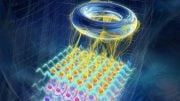
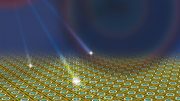



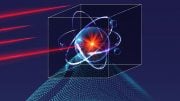
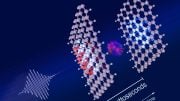

As well as generating entangled photons, this allows us to generate more exotic quantum states of light.
VERY GOOD!
Ask the researcher:
1. What is a photon?
2. What is quantum?
3. What is the physical essence of your exotic quantum states of light?
4. What is the difference between photons and quanta?
5. What is the physical reality of quantum?
7. What is the difference between quantum physics and traditional optics?
and so on.
Topological spin dominates the evolution of all things in the universe, including photons and so-called quantum.
Based on the zero viscosity and absolute incompressibility of space, topological phase transitions occur at any point in space to form vortices, which is not difficult to understand mathematically. Once a topological vortex in spacetime is formed, it will perpetually to rotate until it interacts with other vortices to cancel out, annihilate, or change. This is the synchronous effect of topological vortices.
The rotation of topological vortices is spin. Spin generates gravitation. Spin generates energy. Spin generates evolution. Their interaction via synchronous effect is very interesting. Their superposition includes both logical superposition in space-time and factual superposition in reality. Their entanglement includes both surface entanglement and body entanglement. Their deflection methods are endless. In the interaction and balance of topological vortex fractal structures, spin creates everything in the world.
The universe does not make algebra, formulas, or fractions. The universe is a superposition, deflection, and entanglement of geometric shapes, is the interaction and balance of countless topological vortex fractal structures. In these interaction and balance, the past is difficult to change. For the future, some predictable, some unpredictable. But, the present moment is real, certain, and actionable. Physics should not ignore that low dimensional topological fractal structures are the material basis of high-dimensional spacetime.
Scientific research guided by correct theories can help humanity avoid detours, failures, and pomposity. Please witness the exemplary collaboration between theoretical physicists and experimentalists (https://scitechdaily.com/microscope-spacecrafts-most-precise-test-of-key-component-of-the-theory-of-general-relativity/#comment-854286). Some people in contemporary physics has always lived in a self righteous children’s story world. Whose values have been overturned by such a comical and ridiculous reality?
Misguided by the pseudo-scientific theory of Physical Review Letters (PRL), many researchers do not consider the similarities and differences between geometric shapes and physical reality in physics research, but indulge in imagination, and some scholars’ physics research seriously deviates from science, and they are almost unaware of the dirtiness and ugliness. Although mathematics is the language of science, it must be understood correctly.
I hope researchers are not fooled by the pseudoscientific theories of the Physical Review, and hope more people dare to stand up and fight against rampant pseudoscience.
The so-called academic journals (such as Physical Review Letters, Nature, Science, etc.) firmly believe that two high-dimensional spacetime objects (such as two sets of cobalt-60) rotating in opposite directions can be transformed into two objects that mirror each other, is a typical case of pseudoscience rampant.
Scientific research should be respected, but some people in contemporary physics are not. Please witness the actions of certain individuals and publications. If researchers are really interested in Science and Physics, you can browse https://zhuanlan.zhihu.com/p/643404671 and https://zhuanlan.zhihu.com/p/595280873.
The Physical Review journals, encompassing both hybrid and open-access journals, features 17 peer-reviewed publications including Physical Review Letters, Physical Review X, and Reviews of Modern Physics. CP violation was published in Physics Review in 1956. All so-called peer-reviewed publications of Physical Review family are responsible for clarifying this.
CP violation opened the dirtiest and ugliest era in the history of physics. Countless so-called scientific research and awards have become a self entertaining children’s farce.
Do we really need all this stuff?
It seems to me the only party truly interested in moving huge amounts of data around and computing them in a blink of an eye would be the NSA and similar agencies.
And we know what that means for us.